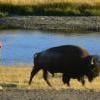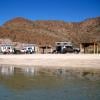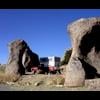
Fleece as soft-side insulation?
#21

Posted 16 November 2011 - 10:39 PM
Frank
2002 Tundra AC TRD 4WD Limited 2009 ATC Bobcat loaded http://sharychic.blogspot.com/
#22

Posted 17 November 2011 - 12:27 AM
Here's my long-winded explanation -- stop reading when it becomes tedious.
The more I read about your fleece idea the more I am convinced it would be better than the factory material. However, it would not have any reflective properties, so there would be no gain from radiation loss. (As I am going to be using a Wave 3 (catalytic) heater saving the radiant heat would be good.) But I strongly agree with the following statement, so I am not sure how to best insulate the pop top.
I don't want another thing in the camper I have to store or spend time setting up and then removing to drive away.I still like to keep it SIMPLE.
Frank
www.KuenzliPhotography.com
2012 Four Wheel Camper - The FWC Build
"If life was fair, Utah would be closer to home" DD
#23

Posted 17 November 2011 - 02:04 AM
The compactibility/foldability of the arctic pack approach (so it can be left in place) seems to me it's big asset.I strongly agree with the following statement, so I am not sure how to best insulate the pop top.
I don't want another thing in the camper I have to store or spend time setting up and then removing to drive away.I still like to keep it SIMPLE.
Hmmm....I don't know how important radiant heat loss is in this situation. I'm not saying it's not significant (though that's my gut feeling), but I just don't know the answer. I know I've done similar analyses in college, but that was a long time ago...The more I read about your fleece idea the more I am convinced it would be better than the factory material. However, it would not have any reflective properties, so there would be no gain from radiation loss. (As I am going to be using a Wave 3 (catalytic) heater saving the radiant heat would be good.)
Hmmm....what about those emergency "space blankets" -- the ones that are basically an aluminized plastic sheet. They only work against radiant heat loss. I've never used one...but would one of those by itself really keep you warm on a cold night? I don't know...but I think that if radiant heat loss was big or significant then more clothing, etc., for cold weather would incorporate a reflective layer.
Whatever the importance of radiant heat loss from the camper in general, I don't think that the fact that catalytic heaters produce radiant heat means you need a reflective surface to contain their heat....unless the hot surface of the heater is pointed at the soft-side. Once the radiant heat from the heater hits an object that object is warmed and the heat is eventually transferred to the air. In other words, it doesn't stay as radiant heat for long.
FWC Hawk (2005) on a Ford F250 Supercab, 6.8L V10 gas (2000)
#24

Posted 17 November 2011 - 02:07 AM
That makes sense and the fibrous fleece does give a lot more surface area.
Special Engel Pricing For WTW Members
Click here to see my ATC Cougar
JayAronowSales.com
(520)579-9610
jayaronow@gmail.com
#25

Posted 17 November 2011 - 02:25 AM
'99 Ford Ranger XLT, '08 FWC Eagle
-------------
“the clearest way into the Universe is through a forest wilderness.” - John Muir
#26

Posted 17 November 2011 - 02:42 AM
Has anyone ever done the science-stunt in which a small amount of water is put in a vacuum (aka "Thermos") bottle with the lid/cap off and put it outside on a cold, clear night? I never have, but the water is supposed to freeze before the ambient air temperature drops below freezing because of radiant heat loss from the water to the cold, cold sky. The vacuum bottle is necessary to keep the water from being in thermal equilibrium with the air outside of the bottle.
Another example of radiant heat loss that I have experienced: When skies are clear overnight, frost can form on the roof of houses or cars even when the temperature of the air is a couple degrees above freezing. This is because the roof loses heat faster to the empty sky than it can gain heat from contact with the air.
I'm sure you're right that radiative loss occurs...but I wonder what the relative contribution is between radiant and conductive heat loss -- how much of each -- from the camper.The longer wavelength infrared will certainly be partially absorbed and re-emitted by the liner - fleece or otherwise - but not totally absorbed. There will be some radiative loss.
One reason why the answer isn't simple/obvious (and so would need a real analysis and be dependent on assumptions) is because the conductive heat loss (and convective if the camper is leaky) will increase when it's windy, but wind won't affect the radiation.
I think I'm gonna refurbish a large vacuum/Dewar bottle, mount it on the back of my truck, and camp in that -- that way I'll know I have the warmest camper possible!
FWC Hawk (2005) on a Ford F250 Supercab, 6.8L V10 gas (2000)
#27

Posted 17 November 2011 - 02:59 AM
Hmmm....what about those emergency "space blankets" -- the ones that are basically an aluminized plastic sheet. They only work against radiant heat loss. I've never used one...but would one of those by itself really keep you warm on a cold night? I don't know...but I think that if radiant heat loss was big or significant then more clothing, etc., for cold weather would incorporate a reflective layer.
The emergency blankets work. I do not know how much of them working is the reflective heat gain or the fact that you are trapping air by wrapping up in a bag. Could do a test, emergency blanket versus trash bag.
Whatever the importance of radiant heat loss from the camper in general, I don't think that the fact that catalytic heaters produce radiant heat means you need a reflective surface to contain their heat....unless the hot surface of the heater is pointed at the soft-side. Once the radiant heat from the heater hits an object that object is warmed and the heat is eventually transferred to the air. In other words, it doesn't stay as radiant heat for long.
Good point. I was picturing all this radiant heat floating around the camper, but you are right, at that point it is hot air. (Sorry, I am really tiered.)
www.KuenzliPhotography.com
2012 Four Wheel Camper - The FWC Build
"If life was fair, Utah would be closer to home" DD
#28

Posted 17 November 2011 - 03:15 AM
I think I'm gonna refurbish a large vacuum/Dewar bottle, mount it on wheels, and camp in that -- that way I'll know I have the warmest camper possible!
Today we were talking at lunch about some camper trailer in Alaska that had about 24'' of spray foam added to the exterior! It had one window and the door cut into the foam, otherwise it was just a big blob of foam.
www.KuenzliPhotography.com
2012 Four Wheel Camper - The FWC Build
"If life was fair, Utah would be closer to home" DD
#29

Posted 17 November 2011 - 03:18 AM
Yep! Both Home Skillet and Pods8 have harnessed the POWER OF FOAM in their custom home-built rigs.Today we were talking at lunch about some camper trailer in Alaska that had about 24'' of spray foam added to the exterior! It had one window and the door cut into the foam, otherwise it was just a big blob of foam.
I'd luv to see a photo of that Alaskan foam-mobile.
FWC Hawk (2005) on a Ford F250 Supercab, 6.8L V10 gas (2000)
#30

Posted 17 November 2011 - 03:26 AM
More about radiant heat loss:
Has anyone ever done the science-stunt in which a small amount of water is put in a vacuum (aka "Thermos") bottle with the lid/cap off and put it outside on a cold, clear night? I never have, but the water is supposed to freeze before the ambient air temperature drops below freezing because of radiant heat loss from the water to the cold, cold sky. The vacuum bottle is necessary to keep the water from being in thermal equilibrium with the air outside of the bottle.
Another example of radiant heat loss that I have experienced: When skies are clear overnight, frost can form on the roof of houses or cars even when the temperature of the air is a couple degrees above freezing. This is because the roof loses heat faster to the empty sky than it can gain heat from contact with the air.
I'm sure you're right that radiative loss occurs...but I wonder what the relative contribution is between radiant and conductive heat loss -- how much of each -- from the camper.
One reason why the answer isn't simple/obvious (and so would need a real analysis and be dependent on assumptions) is because the conductive heat loss (and convective if the camper is leaky) will increase when it's windy, but wind won't affect the radiation.
I think I'm gonna refurbish a large vacuum/Dewar bottle, mount it on wheels, and camp in that -- that way I'll know I have the warmest camper possible!
I agree that it could turn out the radiative heat loss is secondary, but if it were cost-effective, using reflective material would certainly help with the total energy budget. There are actually some fabrics out there with a reflective surface meant for many uses, including clothes, but I don't have a clue how cost-effective they are.
'99 Ford Ranger XLT, '08 FWC Eagle
-------------
“the clearest way into the Universe is through a forest wilderness.” - John Muir
0 user(s) are reading this topic
0 members, 0 guests, 0 anonymous users















